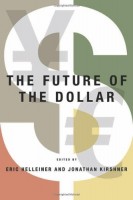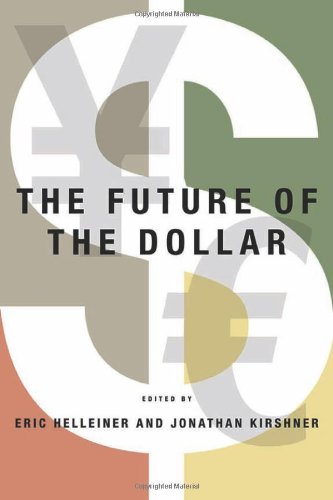 A volume in the series: Cornell Studies in Money. The list of books is available on this website: www.cornellpress.cornell.edu
A volume in the series: Cornell Studies in Money. The list of books is available on this website: www.cornellpress.cornell.edu
Editors: Eric Helleiner and Jonathan Kirshner
Publisher: Cornell University Press – 250 words
Book Review (A Second View) by: Paiso Jamakar
With a long list of books published over the last ten years on the dire prospects for the United States dollar, I was surprised to read so many positive-sounding titles of the chapters in this book The Future of the Dollar, published in 2009.
The eight contributors (including editors Helleiner and Kirshner) have written ten chapters in this book, and many of them have upbeat titles like these below (italicization mine):
- The Future of the Dollar: Whither the Key Currency?
- The Enduring International Preeminence of the Dollar
- U.S. Current Account Deficits and the Dollar Standard’s Sustainability
- Enduring Top Currency, Fragile Negotiated Currency; Politics and the Dollar’s Role
- Housing, Finance, Growth, and the U.S. Dollar’s Surprising Durability
- From Monopoly to Oligopoly: Lessons from the Pre-1914 Experience
- Toward a Leaderless Currency System
- Twenty-First Century Geopolitics and the Erosion of the Dollar Order
- After the (Relative) Fall: Dollar Diminution and the Consequences for American Power
- Summing Up and Looking Ahead: The Future of the Future of the Dollar.
Whereas a cursory browsing of books on the U.S. dollar on the Amazon website with this phrase on the search filed – U.S. dollar decline – will yield you these one dozen books (and there are more):
2014,May –nThe Global Economic Reset: The Day America Loses World Reserve Currency
2014, January – The Big Reset: War on Gold and the Financial Endgame
2013, September – American Exit Strategy (The Economic Collapse Chronicles)
2012, September – Exorbitant Privilege: The Rise and Fall of the Dollar
2012, August – Currency Wars
2012, May – The Little Book of the Shrinking Dollar
2012, May – The Real Crash: America’s Coming Bankruptcy
2011, January – The Day After the Dollar Crashes
2010, December – The Demise of America
2010, October – The Coming Economic Armageddon
2009, August – The New Empire of Debt
2008, April – The Demise of the Dollar
So where is the U.S. dollar headed? Is it going to continue to lose value in the United States itself at least, or is its erosion going to stop someday soon? There is no doubt the actual annual inflation rate in the U.S. is much higher than the average two percent over the last five years that the Federal government reports it is. Has anybody from the Federal Reserve Board gone to their local supermarket lately?
But the dollar’s declining purchasing power does not mean it will be dethroned anytime soon from its pre-eminent position as the world’s reserve currency. Helleiner and Kirshner point out in chapter 1 some of the reasons the U.S. dollar holds such high status:
- Enormous size of the U.S. economy, with Gross Domestic Product at $17.6 trillion
- Institutional depth, having thousands of banks with billions of dollars in reserves
- Large capital markets, including the world’s largest stock market
- Enormous profits, ongoing profitability, and large revenues of U.S . companies
- Political stability for more than two centuries, since its founding in 1776
- Physical security, with a large and sophisticated defense system
The editors write that the purpose of their book is not to take a pro or a con side with respect to the future stability and integrity of the U.S. dollar; rather it is to have their contributors and themselves present facts and numbers relating to this issue.
Those who argue that the U.S. dollar is doomed, such the authors of the books mentioned above, state these facts and make the following supporting points:
- The U.S. government’s enormous current debt of $17.657 trillion exceeds its GDP of $16.785 trillion by almost $900 billion, and the gap continues to widen daily by about $3.5 billion in deficit spending daily, with an annual average of about $1.275 trillion since January 2009 (go to www.USDebtClock.org). A debt repayment plan does not exist.
- The massive deficit spending has been financed through borrowing (sales of debt instruments such as U.S Treasury bonds, bills, and notes.
- Whatever funds for deficit-spending cannot be raised through borrowing is produced by creating money out of thin air: printing of trillions of dollars of U.S. paper currency.
- The sales amount of U.S. government debt has been declining in recent years, with China and other key lenders lending less and less, since the U.S. dollar has lost much value, and continues to decline.







